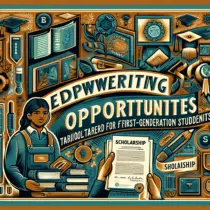Applying for scholarships can be a nerve-wracking experience. With so much competition, it’s essential to make your application stand out from the crowd. One of the most crucial aspects of any scholarship application is the essay. Crafting a compelling scholarship essay allows you to showcase your unique qualities, experiences, and aspirations. It gives you an opportunity to unleash the power of your story and convince scholarship committees that you’re deserving of their financial support.
In this article, we will guide you through the process of creating a compelling scholarship essay that captivates readers and increases your chances of receiving scholarships. Remember, writing persuasively is a skill that can be honed with practice and guidance. So let’s dive in and discover how to unleash your story’s power!
Choose an Engaging Topic
The first step in crafting a compelling scholarship essay is selecting a topic that captivates readers’ attention. Consider your experiences, passions, or challenges that have shaped you. Look for a unique angle or perspective that sets you apart from other applicants.
You might choose to discuss how overcoming a difficult obstacle has influenced your goals and ambitions, or how a particular event inspired your interest in a specific field of study. Remember to showcase your genuine emotions and personal growth throughout your chosen topic.
Structure Your Essay Effectively
A well-structured essay helps convey your ideas clearly and logically. Start with an engaging introduction that grabs the reader’s attention and provides an overview of what they can expect from your essay.
Next, develop the body paragraphs by presenting specific examples or anecdotes that support your main points. Use active voice instead of passive voice to make your writing more impactful and concise.
Finally, conclude your essay by summarizing your main points and reinforcing why you are the perfect candidate for the scholarship. This conclusion should leave a lasting impression on the reader.
Show, Don’t Tell
When writing a scholarship essay, it’s essential to demonstrate your qualities and achievements through vivid storytelling rather than simply stating them. Instead of saying, “I am a determined individual,” show the reader how your determination manifested in specific situations or accomplishments.
For example, describe a time when you faced adversity and how you persevered against all odds. By providing concrete examples and illustrations, you can make your essay more engaging and memorable.
Research Your Audience
Understanding the values and expectations of the scholarship committee is vital in tailoring your essay effectively. Research the organization offering the scholarship to gain insights into their mission statement, goals, and values.
Once you have gathered this information, align your experiences and goals with their expectations. Highlight how receiving this scholarship will not only benefit you but also allow you to give back to your community or pursue endeavors that align with their mission. This alignment will demonstrate your dedication and increase your chances of success.
Edit, Proofread, Repeat
Avoid submitting an essay riddled with grammatical errors or typos. Take time to edit and proofread your work meticulously. Double-check for spelling mistakes, punctuation errors, and ambiguous sentences.
Consider asking a trusted mentor or teacher to review your essay for feedback. Fresh eyes can catch errors that may have slipped through unnoticed. Additionally, seek their advice on ways to strengthen the overall impact of your story.
Frequently Asked Questions (FAQ)
- How long should my scholarship essay be?Most scholarship essays have specific word count requirements. Be sure to adhere to these guidelines and avoid writing excessively long essays that may lose the reader’s attention.
- Can I reuse my scholarship essay for multiple applications?While it may be tempting to reuse a well-crafted essay, it’s crucial to tailor each application according to the specific requirements and prompts provided. Addressing each application individually demonstrates your genuine interest and effort in securing the scholarship.
- Should I use jargon or complex language in my essay?Avoid using jargon or complex language that may confuse or alienate the reader. Opt for clear, concise language that is easy to understand by a wide audience.
Crafting a compelling scholarship essay is a crucial step towards securing financial support for your academic journey. By choosing an engaging topic, structuring your essay effectively, showing rather than telling, researching your audience, and thoroughly editing your work, you can unleash the power of your story and increase your chances of receiving scholarships. So embrace this opportunity with enthusiasm and let your unique voice shine through!</p






